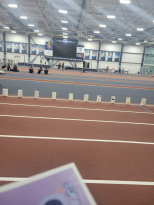Paired with quantum physics? Classical Indian dance
“Day” and “off” are two words that, when put together, Ramya Gurunathan doesn’t hear very often. Science majors are busy, but Gurunathan’s schedule is packed with more than just physics problems and lab experiments.
Besides preparing for her quantum physics lectures, Gurunathan spends a good portion of her time with the women of PSU Natya, the classical Indian dance team at Penn State. This year is the first time the team received university funding, but the team has been dancing for the past three years.
Gurunathan practices Bharatanatyam, one of seven types of classical Indian dance. Bharatanatyam originates from south India. Living in Pennsbury, Pa., Gurunathan began her study of the complex art form 11 years ago, when she was seven. Unlike some performers who are cajoled into dance by their parents, Gurunathan said her career in dance began under her “own volition.” She said she was inspired to begin dancing after her parents took her to some classical Indian dance performances, and she was awed by the dances.
Her love for the art only grew as she continued her training. Bharatanatyam and classical Indian dance are as much about tradition as they are about skill. Gurunathan completed her senior ceremony, called an Arangetram, the summer after her sophomore year at Pennsbury High School in Fairless Hills, Pa. After perfecting 10 different dances, a dancer completes her Arangetram over a two-hour solo.
Now, with her slender frame and dark hair and eyes, Gurunathan is one of those dancers that she so admired growing up. After years of training, she has reached one of the more advanced stages of her chosen art form.
Despite her commitment training in high school, Gurunathan said she wasn’t sure if she wanted to join the dance team or focus on her schoolwork when she arrived at Penn State. However, she said she decided to join PSU Natya in order to be more involved in the creative process.
When studying under a teacher, the student performs choreography created by the teacher. But, the PSU Natya team is in charge of its own choreography, Gurunathan said. She added that the experience is “totally different” as the team members must “interpret ancient Hindu stories” and choreograph a performance that portrays the story to the audience.
Gurunathan noted that most of the nine women on the team are majoring in engineering or the sciences, so the dance team and choreography provides one of their only opportunities for a creative outlet.
One of Gurunathan’s recent practices focused heavily on the creative aspect of PSU Natya. Before practice began, Gurunathan and her teammates prepared to dance by putting on their bells. Each dancer wears a leather strap with four rows of 10 bells. The leather straps are secured around each ankle.
While putting on her bells, Gurunathan explained that receiving the first set of bells is a special experience for a dancer. A teacher usually presents the bells to the dancer, but before the dancer can receive the bells, she must master and perform a solo series of dances, Gurunathan said. The giving of bells signifies that the dancer is ready to proceed with the final and more advanced parts of her training.
Although the women of PSU Natya comfortably laugh and joke with each other, they are committed to their craft. When it was time for practice to begin, Gurunathan and her teammates stopped being casual college students and immediately transformed into seriously focused dancers.
Before beginning their practice, Gurunathan began the practice session with the ancient ritual of namaskaram, or touching the floor as a sign of respect. Gurunathan brought her hands up to her chest and kept her elbows parallel to the ground. She tapped her feet on the ground as she brought her hands up to her shoulders. She then extended her arms and bent to the ground at the knees, keeping her back straight. She touched the ground and then her eyes. Finally, Gurunathan straightened up, pressing her palms together in front of her.
As her teammates followed her graceful motions, Lorrain Hossain, Gurunathan’s teammate and friend, explained that the namaskaram is a way to “take blessing from the ground.” Because the dancers will be stomping on the ground, they need to begin practice by asking the ground’s blessing and permission, Hossain said.
The dancers lined up in the corner of the room, and when the music filtered through the speakers, the women gracefully glided out to the center of the floor.
The dancers acted out an ancient Hindu story, and Gurunathan was playing the part of a thief in this particular narrative. She glanced furtively around the room as she played her part. Her movements across the floor were quick and sharp. She extended her arms and glanced at the audience, as if daring them to ask her to reveal her secrets. With another anxious glance, Gurunathan looked at her teammate who played the second thief. Gurunathan took another furtive glance around the room, then straightened up.
She joined the rest of the dancers in the center of the floor. With delicate extensions of her arms contrasting the stomping of her feet, Gurunathan was mirroring her fellow dancers. The dancers were extending their arms, as if inviting the audience.
All throughout the 10 minute dance, the bells around the women’s feet jingled feverishly as they stomped their feet on the floor. Finally, following a rise and fall in the music that mirrored the rise and fall of a plot line, the story was over and the music died out.
As quickly as they became into serious artists, the women fell back into their roles of friends and lighthearted college students when the performance was finished.
In order to be prepared for three or four competitions a year, Gurunathan and the team adopt a rigorous practice schedule. During the fall semester, which is the competition off-season, the team practices twice a week. But during the spring semester and the height of competition season, the team practices four to five times a week. Often, in order to accommodate everyone’s schedules, the practices will be held late at night.
“Sometimes we’ll practice from 10 to midnight,” Gurunathan said. The team also practices on Sundays. Gurunathan has to manage her dance schedule with her regular studying.
Caitlin Gibbons, Gurunathan’s roommate said it’s rare to find Gurunathan not studying or working. “I’ll see her after 10 or 11 every night,” Gibbons said.
Gibbons added, “She has the best work ethic I’ve ever seen in anybody.”
Gurunathan and her team spent time brainstorming ideas for next year’s choreography. The women struggled to decide between a more modern idea that featured timeless elements, like an adaptation of the Disney movie, Mulan or a more traditional historical or religious story from Indian history.
Preeti Rangaraj, another teammate and friend of Gurunathan, explained that the competition judges award points for both traditionality and originality, so the team needed to strike a balance between the modern and the ancient.
But, finding this balance is what makes performing with PSU Natya so fulfilling for Gurunathan. She said finding an ancient story and making it relevant to today’s society was one of her favorite parts of Indian dance.
“I really love digging back into Indian culture,” Gurunathan said.







